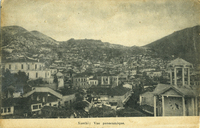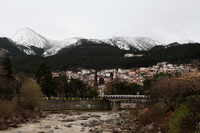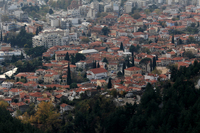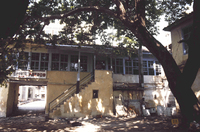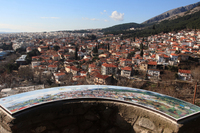Entrance from the North Side
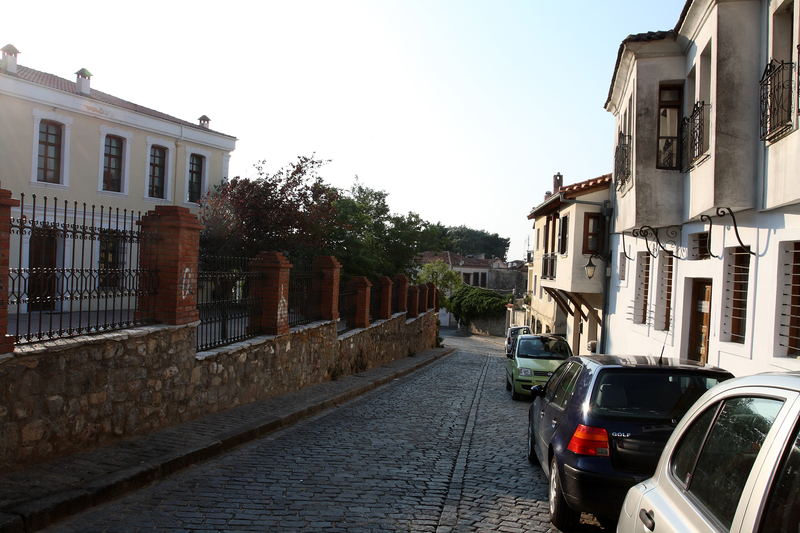

At the centre of the photograph taken back in 1940, you can clearly spot the late Byzantine acropolis of Xanthi.
Today, it is difficult for someone to spot the old walls at the North West side of the city because they are covered with vegetation. Therefore, from the 14th century onwards, the city is referenced frequently on documents as a township or town. However after the reconstruction of the city which took place from 1830 to 1845, the city has grown and it got shaped up to the state it has today. The reconstruction of the city started after a catastrophic earthquake which happened during the spring of 1829. So during this period of reconstruction, between 1830 and 1845, there were many workshops with craftsmen from Epirus which appear in the city. Later on there was also an additional phase of construction development which started in 1870 and continued to the following years. This happened because the city of Genisea, a close by city taken its name from the Genisea lowlands, was the administrative centre of the local area. However, a fire destroyed Genisea city and so all the administration and commerce activities were transferred to the city of Xanthi.
In the picture you can see a sign from 1880. You can find this sign at the arcade which leads to the khan or guesthouse of Margaritis at the area of the marketplace. During maintenance activities of the sign, a fault lead to a spelling mistake on it. Now you can read <<..Margaritis Isaiou..>> However the correct name according to the spelling rules of that age should be <<…Margaritis Ioanou…>> on that sign you can also read that this person was coming from Epirus. The multicultural social life of the city during the past centuries, was structured around churches and temples and this was how neighbourhoods were formed. It is worthy considering that in the city someone can find Greek orthodox churches, Catholic churches, Jehovah’s witnesses churches, evangelist churches, Armenian churches, Pentecostal churches, but also mosques, Bektashi tekke and vaulted tombs.
Members of wealthy urban families were building houses, usually with 2 levels and with additional storage facilities, houses which their architecture trends were a mix of the traditional ones as well as Balkan and west European. There are many tobacco merchants from Xanthi who were “active” socially and financially in many European cities. They were generating more and more incomes from crop growing and processing of tobacco at the border region of Xanthi. Tobacco merchants were distributing tobacco at all the major European markets as well as the Asia. South of the city of Xanthi and at the outskirts of the fertile plain, modern and large warehouses as well as cigarette factories were built. This industrial development, brings other people from different locations to the city of Xanthi. All these people, workers and professionals, were organised in Unions and Parties. Therefore at that point in time in the city of Xanthi, there were Thrakians, people from Asia Minor,Pontus,Cappadocia, Armenia, Black Sea,as well as people of Epirus,of Turkish origin,Pomaks, Gypsies, Sarakatsans and Albanians. The development of the city is noticeable and there are records of more than 50 guesthouses which existed during these times. The latter fact shows a very active commercial activity in the regions.
In the picture you can see a sign on Dagli street, which says guesthouse or “guesthouse Averof First Class", on the portico of Michael Karaoli Street which is at the centre of the city and close to the end of Dagli Street. This picture was taken on June of 1991 and just before the sign was taken down. Many parts of Theodoros Anggelopoulos’ film “O Thiassos” were filmed in this spot. Today the structure of the Old City is largely maintained against the decisions of the local authorities. This was achieved in the mid 1970s thanks to the efforts of the ex governor of the city Mr Konstantinos Thanopoulos as well as the efforts of Chief Inspectorate of Classical Antiquities of Komotini Mr Evangelos Pentazou. Also this combined effort was enforced by groups of people like the members of the Progressive Union of Xanthi ( FEX ) and the city was finally proclaimed as “Traditional Settlement”(FEX.661 05.17.1976) The new city now extends south and west. In the picture you can see the old and the modern city of Xanthi as well as the valley and in the background you can see the island of Thassos. PAKETHRA has created a location of panoramic view, which is in the Samakov district.
X
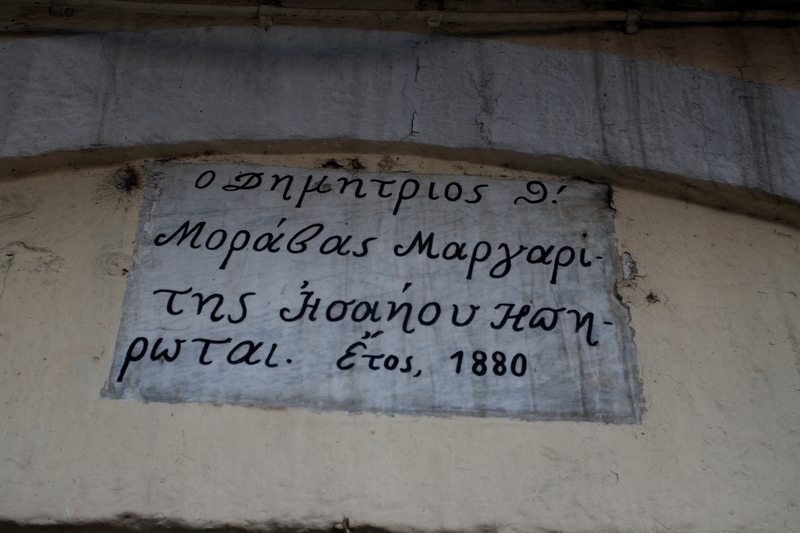
Copyright © Στην εικόνα βλέπεται μία επιγραφή. του 1880, η οποία βρίσκεται επί της στοάς, που οδηγεί στο χάνι του Μαργαρίτη, στην περιοχή του παζαριού. Όμως, με την συντήρηση της επιγραφής, από λάθος έχει αναγραφεί : «... Μαργαρίτης Ησαήου...», ενώ το σωστό είναι, με την ορθογραφία της τότε εποχής : «... Μαργαρίτης Ηοάνου...». Μπορείτε να διαβάσετε, ότι ήταν Ηπειρώτης.
X
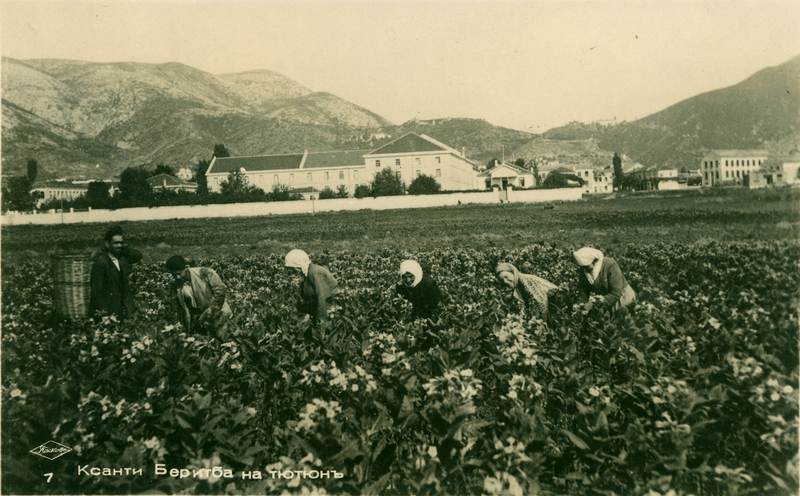
Copyright © Καπνοκαλλιεργητές και στο βάθος τα καπνεργοστάσια και η πόλη της Ξάνθης. Καρτ ποστάλ του Βούλγαρου φωτογράφου και εκδότη G. Paskoff τυπωμένη στη Σόφια το 1940, γραμμένη στα βουλγαρικά. Ταχυδρομήθηκε από την Ξάνθη στην Βουλγαρία, το 1943. Συλλογή Β. Αϊβαλιώτη.
X
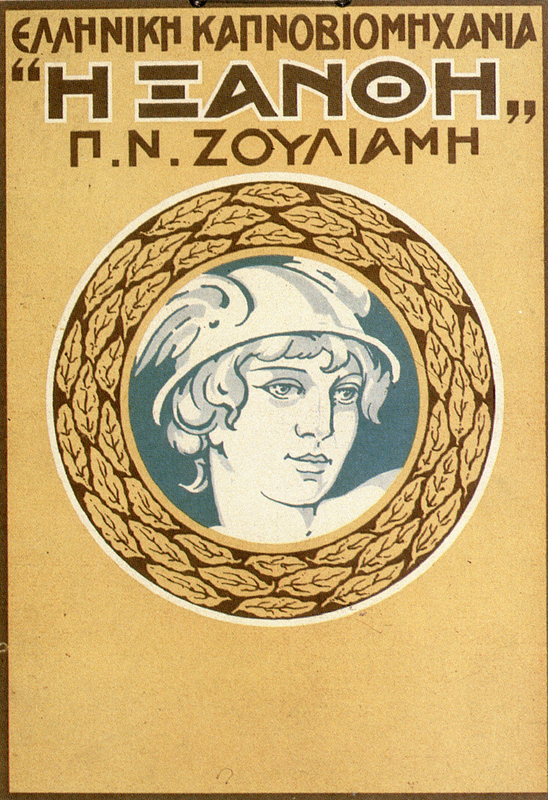
Copyright © Σήμα της καπνοβιομηχανίας "H Ξάνθη" Π.N. Zουλιάμη, 1929-1931. (Φωτογραφία: Πάντσογλου Χρήστος)


